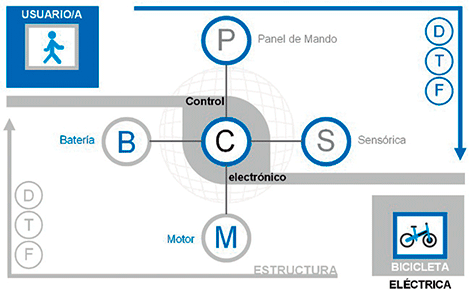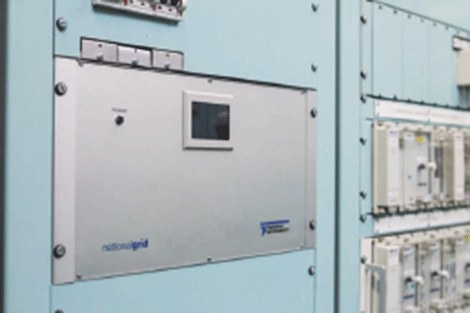“The CompactRIO platform has allowed the development of a versatile and easy-to-use application applicable to monitoring the behavior of electric bicycles” – Gorka Gainza González, Aresse Engineering SL
The challenge:
The challenge for the team made up of Quipplan and Aresse, National Instruments Alliance Partner, is to develop a flexible and autonomous platform that allows the acquisition of operating parameters of different bicycle designs both on the bench and on the road and to store the data obtained with a view to design optimizations.
The solution:
As an acquisition system, due to its features in terms of autonomy, robustness and stability, a CompactRIO with three different modules is chosen depending on the type of signal and the sampling rate transmitted through the FPGA.
The challenge
Quipplan is a product engineering that offers a comprehensive service since it is "an engineering with a workshop and a workshop with engineering":
•Design engineering and product development for third parties.
•Product design from conception to projection.
•Product development until its industrialization.
•Aesthetic-functional prototypes in all kinds of materials and sizes.
•Verification and validation of the product.
•Manufacture of tools, both for manufacturing and for verification and testing.
•Design, development, production and marketing of own products.
•Investment and promotion of companies in the field of new synergistic technologies with their activity.
•Manufacture of short series of plastic and metallic components.
Quipplan Mobility is Quipplan's sustainable mobility area, where Electric Bicycles are designed, developed, manufactured and marketed. Electric bicycles constitute an important technological challenge since they are complex vehicles where the user-vehicle interaction is carried out through various channels: the traditional ones of the bicycle: Steering (D), Transmission (T), and Brakes (F), where the vehicle's response is direct, and those specific to pedaling assistance: Control Panel (P) and Sensors (S) where the response comes from data processing in the Electronic Control (C) and is translated into a certain operation Battery (B) and Motor (M). All this supported by the structural elements of the vehicle. The correct integration of the two elements in the final assembly is crucial for the correct operation of the vehicle. The launch of our first range: q10 by quipplan complies with the principle of integrating all the elements, both electrical, electronic and mechanical, offering the market an optimized and highly innovative product. The challenge for the team made up of Quipplan and Aresse, National Instruments Alliance Partner, is to develop a flexible and autonomous platform that allows the acquisition of operating parameters of different bicycle designs both on the bench and on the road and to store the data obtained with a view to design optimizations.
The solution
Hardware and instrumentation platform description
From the instrumentation point of view, in order to evaluate the flow of energy from the battery to the electric motor as well as the contribution of the latter to the movement of the bicycle depending on the operating conditions, the following channels are monitored:
•Voltage and current between phases of the electric motor.
•Voltage and current at the output of the battery.
•RPM's of motor wheel shaft.
•Resistive torque and other analog channels available for test bench parameters.
•Actuation of brake caliper.
• RPM's of the bottom bracket.
As an acquisition system, due to its features in terms of autonomy, robustness and stability, a CompactRIO with three different modules is chosen depending on the type of signal and the sampling rate transmitted through the FPGA.
The entire acquisition system and external sensors are powered from a 12V, 3Ah lithium-ion battery for complete autonomy of the system on the road for more than 5 hours of operation. The integration also includes a terminal block to facilitate the connections between the acquisition system and the circuit between the electrical components of the bicycle and its control drivers.
Application Description
configuration module
To manage the cRIO acquisition, a module has been developed that allows configuring the channels from the point of view of assignment to the cards, nomenclature and sensitivity. Through an FTP service between the PC with which the configuration is being carried out and the cRIO itself, the configuration file is transmitted, being able to download the file used by cRIO at any time, update it and generate new ones. Among the configuration options is the possibility of storing the data directly in the cRIO memory, used for en route acquisition, or on the PC, for event monitoring in test benches.
Regarding the fast channels, those associated with the management of the drivers on the battery voltage, it is possible to configure the downsampling options.
acquisition module
When the system is operating autonomously, en route, the cRIO begins acquisition as soon as power is applied. It does so according to the configuration file provided in the previous module.
Its operation consists of digitizing the described channels and storing them in two different types of TDMS files named with the date and time of monitoring:
•A TDMS file for slow channels, in which all the data of tensions, rpms and operating conditions are continuously stored.
•Multiple TDMS files to slice the fast channel data into 20 second segments.
When the monitoring allows the use of a computer, such as in the case of test benches, in order to help in the interpretation of the test, a module has been developed that allows the visualization and management of the data acquisition.
Display module
Once the acquisition is complete, whether en route or at the bank, the application itself manages the visualization and offline analysis of the generated files.
Using an explorer, the TDMS files are located, whether they are fast or slow channels, and it is possible to configure their graphic display.
Conclusion
The CompactRIO platform has allowed the development of a versatile and easy-to-use application applicable to monitoring the behavior of electric bicycles.
Quipplan uses it as a tool for evaluating the assisted pedaling system, both for diagnosis of a system in service, and for evaluation of new systems and/or modifications. Given its portability and autonomy, it is used not only on a test bench but also for Acquire data in the field, and thus provide feedback on bench test events, optimizing them to achieve a test cycle that is more representative of the real application cycle.







